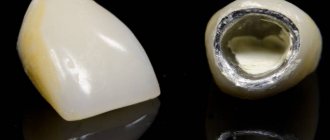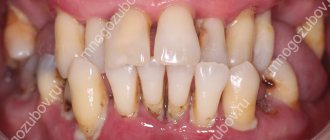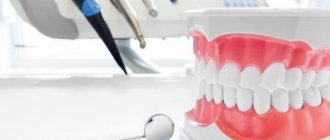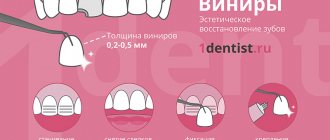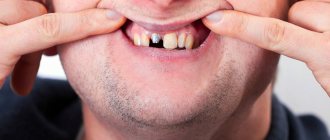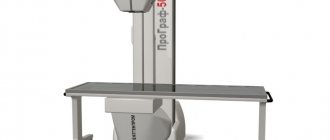2731
Dental crowding is the most commonly diagnosed dental pathology. According to statistical studies, the anomaly, to a greater or lesser extent, occurs in every third child and every second adult.
And although the vast majority of owners of such a “gift” of nature are not too worried about this, it is necessary to treat the pathology.
The types of the disease, methods of its treatment and causes will be discussed in this article.
Diagnosis of “crowded teeth” – what does it mean?
Dental crowding is a pathology characterized by close positioning and rotation of teeth. Because the teeth are too close together, some of them erupt outside the arch and overlap each other. This anomaly has several degrees of severity:
- mild
- when the crowding of teeth within one jaw is approximately 2-3 mm; - medium
- when it reaches 4-6 mm; - strong
- more than 7 mm.
Crowding can form on one or both jaws, as well as simultaneously in the anterior and lateral regions. In addition, the curvature, if left untreated, worsens over time, which leads to very sad consequences and requires more serious treatment. An interesting fact is that crowding of the lower teeth is several times more common than the upper teeth.
Main causes of the anomaly
Dental crowding occurs both at the level of the teeth and dentition, and due to improper development of the jaws. In the first case, the causes of its appearance are “eights”, as well as supernumerary teeth, or hyperdentia, and macrodentia - a pathology associated with an increase in the size of one or several teeth. "Eights", or third molars, appear quite late, at 16-27 years of age, and they often do not have enough space in the jaw. Once they erupt, they “pull” other teeth, which can cause crowding. The reasons for the formation of macrodentia and hyperdentia have not been fully studied, but most experts believe that it is a matter of heredity.
Often the cause of crowding is a small jaw - all the teeth simply cannot fit on it. Underdevelopment of the jawbone is influenced by early loss of teeth and lack of replacement, heredity, defects that arose during the formation of the fetus, as well as such bad childhood habits as infantile swallowing, mouth breathing and sucking of irregularly shaped pacifiers or bottles.
One of the bad childhood habits is worth talking about in more detail - this is the mouth type of breathing, which develops due to pathologies of the ENT organs. Outwardly it appears like this: the mouth is slightly open, the upper lip is upturned, the oval of the face is elongated; as it progresses, an adenoid type of face may form.
At first glance, a harmless habit negatively affects the condition of the child in general and the dental system in particular:
- the dentition on the sides narrows;
- little space for permanent teeth;
- the structures of the upper and lower jaw are not fully formed;
- weak tone of the orbicularis oris muscles;
- the dome of the sky becomes higher;
- the configuration of the nasal membrane is disrupted;
- problems with sound pronunciation, articulation;
- overload of the temporomandibular joint and the occurrence of facial muscle pain.
After treatment, such as adenoid resection, the habit of breathing incorrectly often remains. It is necessary to re-teach the child to breathe through the nose, constantly strengthen the orbicularis oris muscle and use an elastic trainer with a vestibular plate (2 times for 30 minutes during the day and at night). Regular exercises restore normal breathing within 3 months.
Anomalies formed at the jaw level are more difficult to correct, especially when it comes to adult patients - in such situations it is often necessary to sacrifice healthy teeth and resort to the help of an oral and maxillofacial surgeon.
Causes
Teeth crowding occurs for two main reasons:
- congenital;
- acquired.
Among the congenital factors that provoke a violation of the position of the teeth are:
- Genetic predisposition, manifested in the form of macrodentia. The latter is characterized by the presence of abnormally large teeth.
- Micrognathia. With this pathology, the patient is diagnosed with an abnormally small jaw, as a result of which the teeth “grow” on top of each other, thereby filling all the available space.
- Meosidence. The disease is characterized by the appearance of extra teeth. Meosidence is rare.
Acquired factors include:
- specific eruption of permanent molars and wisdom teeth;
- prolonged use of a pacifier by a child;
- too early removal of milk teeth, in the place of which permanent teeth do not appear for a long time;
- long-term course of respiratory diseases ;
- curvature of the jaw caused by rickets or metabolic disorders before the eruption of permanent teeth;
- pathologies of soft tissues, due to which abnormal development of dental arches occurs.
Teeth crowding usually develops in childhood, when temporary molars are replaced by permanent ones. As a result, even in childhood, a person often develops dental pathologies. They occur due to a large accumulation of plaque and stone in the places where the molars overlap each other.
How to fix crowded teeth in children
The absence of spaces between the primary canines in a small child is a sure sign that there is not enough space in the jaw. And if even baby teeth can’t fit on it, then molars definitely won’t be able to fit either. Treatment at such a young age is usually not carried out, since it is difficult to force very young children to wear orthodontic appliances, even removable ones. However, it is during this period that one very important thing needs to be done - get rid of bad habits that cause crowding: wean the baby from sucking his finger and pacifier, teach him to swallow correctly and eliminate the cause of mouth breathing.
Treatment of crowding of the upper and lower teeth in the early mixed dentition, that is, starting from 6 years of age, is carried out with the help of plates, as well as trainers, LM-activators, palatal expanders and other functional devices. At this age, it is especially effective to correct the size and position of the jaws, but it is not always necessary to correct crowding during this period. Of course, it will be possible to straighten the dentition, but there is a high probability that they will return to their previous position after the remaining molars erupt. This is why many orthodontists recommend delaying treatment until 11-13 years of age, when the bite is fully formed.
A specialist can prescribe a young patient a set of myogymnastic exercises that normalize the functioning of the oral muscles. To achieve the necessary results, it is enough to devote only 7-10 minutes a day to gymnastics. This way you can avoid not only the development of malocclusion, but also problems with the musculoskeletal system in the child.
Examples of myogymnastic exercises
✔ Button.
Hold a large flat plastic button horizontally between your lips, first for 1 minute, then for 3-5 minutes.
✔ Ruler.
Press the edge of a ruler 8-10 cm long with your lips, while holding it horizontally. Next, increase the load by placing a small object on the ruler.
✔ Air.
With your lips closed, blow air first under the upper and then under the lower lip.
✔ Cheeks.
With your lips closed, puff out your cheeks, and then slowly squeeze out the air with your fists through your clenched lips.
To eliminate anomalies in adolescence, inexpensive designs are used - the price of ceramic braces is quite justified in terms of aesthetics and treatment effectiveness, and the most disciplined children are even fitted with aligners - removable transparent aligners that must be worn at least 22 hours a day. However, even at this stage, specialists are faced with certain difficulties in the form of wisdom teeth that have not yet appeared, so they are faced with a very important question - is it worth carrying out treatment before they erupt or not?
How is anesthesia done?
There is no pain during dental implantation due to the procedure using local anesthetics. For patients with a very high sensitivity threshold, the use of medications for general anesthesia is provided. To help the patient overcome fear and reduce anxiety, the dentist may give a sedative.
Before the procedure:
- Local anesthesia. During the procedure, the doctor injects Ultracaine or Articaine into the operated area. The drugs block the transmission of nerve impulses from the nerves passing through the base of the tooth. In some cases, painkillers are injected into the trigeminal nerve area to provide truncal anesthesia. The effect of the therapeutic effect of the drugs lasts from 4 to 6 hours, so within 2-4 hours after the end of the operation the person feels numbness in the oral cavity. During the procedure, the patient does not experience pain, but feels the movements of the instruments.
- Superficial anxiolysis or minimal sedation. The patient is given oral medications that relieve him of anxiety and fears before surgery. One of the side effects of psycholeptic drugs is mild drowsiness. These medications do not help eliminate pain, so when installing dental implants they are used only in combination with local anesthetics.
General anesthesia is rarely performed and only in the following cases:
- In case of individual intolerance to local painkillers;
- When panic attacks occur;
- For pediatric patients;
- With a strong gag reflex;
- When installing more than 6 dental implants together with osteoplasty.
During general anesthesia, the patient is completely unconscious and does not react to external stimuli. In this case, any muscle activity stops, breathing is supported by a ventilator, which requires the presence of an anesthesiologist during the operation. The patient regains consciousness 20 minutes after stopping the supply of the drug for general anesthesia.
Crowding and wisdom teeth
There are many situations where the eruption of “eights” led to repeated crowding, but this is not at all a reason to refuse early correction of the anomaly. “Wise” teeth are formed by the age of 12, which allows you to see them in the picture and create a treatment plan taking into account the peculiarities of their eruption. Of course, if there is not enough space in the bone, experts prefer not to take risks and remove wisdom teeth in their infancy in order to avoid recurrence of crowding. Waiting for the “eights” to erupt is also not entirely reasonable, since they can appear either very late - around the age of 27, or remain retained. If there is enough space in the bone, wisdom teeth should not be removed - if they erupt correctly, they will be included in the chewing process.
Interesting fact!
Wisdom teeth are one of the rudiments of our body. They rarely participate in the bite, are not always formed and quite often - in about 20 - 25% of cases - remain impacted, that is, they do not erupt. Therefore, if a patient is indicated for tooth extraction due to their crowding, attention should be paid to the “eights” first.
Treatment with braces
Braces can correct crowded teeth in both adulthood and adolescence. There are several options for eliminating crowding orthodontically:
➢
expansion of the dentition;
➢
separation (grinding the contact surfaces of teeth);
➢
distalization, that is, the movement of teeth towards the lateral ones;
➢
extraction (removal).
X-rays, in particular teleroentgenograms and computed tomography, help determine which treatment method is suitable in a particular clinical case. Using them, the specialist determines the volume and condition of the bone tissue, the type of gum, and based on the data obtained, draws up a plan for moving the teeth.
Important!
In order to avoid relapse, after removing braces, it is mandatory to wear a retainer - a thin plate that is attached to the lingual side of the teeth. The period of wearing it is twice as long as the duration of treatment.
Tooth extraction for overcrowding
Unfortunately, in some cases, it is not possible to treat crowding with braces without removing teeth. For example, it cannot be avoided when there is not enough space in the jaw for teeth to move. As we found out, the first candidate for removal is a wisdom tooth. However, even its absence does not guarantee the presence of space in the bone. In this case, experts recommend removing “fours” and sometimes “fives”. Removing even two teeth helps to “get” 6 to 8 mm of free space.
Another indication for extraction is supernumerary teeth and macrodentia. If they are removed at an early age, the dentition can take the correct position on its own and will not require orthodontic correction. However, at a later age you cannot do without it.
Expected Result
The main thing that orthodontists count on when insisting on tooth extraction before placing braces is to obtain the opportunity to carry out the most successful bite correction and improve the patient’s appearance.
It is also important to understand that forced extraction speeds up the correction. After this manipulation, traction, which promotes the movement of teeth, encounters less resistance from the bone tissue.
Due to the pressure created by the arc, on one side the periodontium is compressed, and on the opposite side it is stretched. Where there was compression, special cellular structures are formed - osteoclasts, and bone resorption begins (i.e. resorption).
On the side where the stretching occurred, osteoid tissue (transitional) is formed, which over time will degenerate into bone, i.e. bone is growing.
The processes of resorption and growth are not synchronized. Typically, resorption proceeds faster than the formation of new tissue. It is for this reason that bite correction is a long process, and you need to wait until the bone tissue “ripes” around the new tooth position.
DETAILS: The first day after installing braces, the first days of wearing
Upon completion of treatment, the gap formed at the site of the removed element closes in 4-6 months. due to the displacement and rotation of the remaining units.
Teeth crowding: treatment without braces
One of the most common alternative methods for treating crowding is separation - minimal grinding of the contact surfaces of the teeth, no more than 0.5 mm. Separation allows you to get up to 4 mm of free space, which in some situations is quite enough for leveling. During grinding, it is very important not to overdo it and not remove too much hard tissue, which can lead to increased sensitivity of the tooth.
In some cases, crowding is eliminated by installing veneers, lumineers and crowns. However, orthopedic structures can only be effective for minor curvatures. Otherwise, in order to install them, you will have to grind down the tooth, which will lead to extremely disastrous consequences.
Important!
Orthodontic structures will help correct the position of the teeth, but not their shape and size - veneers, lumineers or crowns are installed for these purposes.
Crowded teeth: photos and causes
Doctors are not always able to determine why this pathology occurs. As a rule, the causes are certain habits and diseases of the oral cavity. In adults, this anomaly appears at the moment when wisdom teeth begin to erupt. In such a situation, molars and canines already occupy free spaces, and the eights have nothing left, so they move neighboring units, taking up the necessary space.
Bad childhood habits often lead to dental crowding. To avoid such a pathology, parents must promptly wean their baby from using pacifiers and nipples, finger sucking, infantile swallowing, and other things. This pathology can also occur as a result of early loss of baby teeth and the delayed appearance of molars in their place.
A naturally incorrect bite is often the cause of crowded teeth. This pathology completely affects the shape and size of the jaw, as well as the location of the incisors, canines and molars. If the alveolar processes are underdeveloped, a similar anomaly may also occur.
In addition, dental crowding occurs with problems such as:
- Various diseases that affect the improper development of the jaw arch.
- The presence of supernumerary teeth, when there are slightly more than the required number of teeth.
- Underdevelopment of the lower jaw.
- Too wide teeth, taking up more space, thereby displacing the units that grow later.
- Hereditary pathologies that provoke the appearance of hyperdontia or macrodentia.
Crowding of teeth must be corrected, or the resulting complications will have to be eliminated. An orthodontist treats this anomaly.
Duration of treatment
Correcting crowding at the level of teeth and dentition takes from six months to two years, depending on the complexity of the clinical case. It is better to normalize the position and size of the jaws from childhood - with proper treatment, this will take no more than six months. In adults, it will not be possible to correct bone curvatures only with the help of orthodontic treatment - you will have to seek help from surgeons.
Interesting fact!
Typically, orthodontic treatment is performed on both jaws; in rare cases with slight crowding, treatment can be performed on one jaw.
Treatment methods
Modern orthodontic developments make it possible to successfully treat crowding. Based on the characteristics of the clinical picture of the pathology, one or another correction procedure may be indicated.
Braces
Most often, such treatment is justified when the form of the anomaly is not too serious.
The course of correcting the defect will take several months, if you follow all the specialist’s recommendations, the effect of the treatment is visible and lasting. For each patient, the time to use the systems is selected individually - it depends on the age group, the quality of the periodontal tissues, as well as the presence of concomitant diagnoses.
Various models of such structures make it possible to align the jaw row due to the formation of an oval of the correct shape formed by an arch. Thus, abnormally deployed organs are placed in the correct place.
The cost of the procedure varies in the following range: installation of the product from 20 to 60 thousand rubles, excluding the price of the braces themselves, since here the amount is determined by the material from which the structure will be made. Their minimum cost is about 14 thousand rubles.
Design features of metal and ceramic non-ligature braces, their advantages and disadvantages.
Here we will discuss the tactics and effectiveness of treating defects using T4K trainers.
Follow the link https://orto-info.ru/zubocheliustnye-anomalii/okklyuzii/glubokiy-prikus.html to figure out how to correct a deep bite in adults.
Tooth extraction
If there is insufficient free space in the jaw row, especially at the stage of advanced type of crowding, the patient has no choice but to resort to the removal of part of the organs. First, the outermost lateral teeth are amputated; they are also called wisdom teeth.
When the clinical situation is too advanced, sometimes even such a radical measure is not enough and premolars have to be removed.
This mainly concerns the lower jaw, since it is much more subject to deformation and mechanical pressure than the upper jaw. Due to this, its natural size becomes somewhat smaller over time, and with such a diagnosis, this is a rather aggravating factor.
Depending on the severity of the disease, the course of treatment can range from 2-3 weeks to 1.5-2 months. After removal of all necessary organs, the installation of orthodontic structures is indicated.
The cost of the removal procedure is standard and depends on the region, clinic and the cost of pain medication. The minimum price for amputation of one organ will cost the patient an average of 5 thousand rubles.
Separation
Such treatment will be effective only if the pathology is not very pronounced. It is carried out by slightly grinding down the enamel surface (mechanical principle of separation) or installing clearance spacers (physiological version of separation).
The first case is the opportunity to free up to 0.5 cm of interdental space.
It is worth noting that many experts consider separation as a completely worthy alternative to amputation of fragments of the jaw row.
The procedure is carried out quickly, sometimes 2-3 visits to the dentist are enough. The cost of the service is from 300 rubles for interdental separation of a single fragment.
Aligners
The devices are used for initial and moderate severity of the anomaly. With the help of aligners, treatment proceeds much slower (within 1 year), but this procedure is much more comfortable for a person.
The price of structures is several times more expensive than braces, but the effectiveness of such treatment is much higher.
The principle of eliminating the problem of crowding is to apply gentle but regular pressure on the jaw row. With the help of the habituation reflex, organ fragments are rotated into the correct position.
There is a psychological “memorization” of the desired position by the teeth, which is developed throughout the entire course of treatment and is gradually corrected with each subsequent replacement mouth guard.
Transparent and thin in appearance, they present no difficulty in wearing. The course of treatment is about a year. Their cost is determined by the complexity of the correction and the number of aligners that need to be made.
If there is overcrowding, about 40 units will be required; this service will cost the patient approximately 200-260 thousand rubles.
Expansion of the dentition using plates
Such manipulations are permissible only after an in-depth study of the qualitative condition of periodontal tissues. The doctor records the presence of the amount of hard bone tissue required for the procedure.
The manipulation itself is done using several methods, but most often plates are used. The effect is achieved by systematic pressure of the expansion plate on the jaw row, and gradually giving its fragments the correct position.
Products are made individually. The best results in this way were observed in children and adolescents, whose bones are not yet fully formed and are more susceptible to changes in position than in adults.
The design is standard - a plate, mounting screws and a metal spring. The devices are fixed with clasps.
The course of treatment depends on the situation. This is generally a period of 6 to 12 months.
Price – from 6,500 per unit, plus about the same amount of services for installation, control and subsequent removal of the device.
In the video you will find out whether it is possible to treat crowded teeth without braces.
Is it possible to leave everything as is?
Firstly, crowded teeth are very difficult to clean, so caries often form in hard-to-reach places. Very often, its development proceeds unnoticed even by specialists, as a result of which the disease is detected already at the stage of acute inflammation, when not only the tooth is affected, but also the surrounding hard and soft tissues. It is not always possible to save such a tooth.
Secondly, crowded teeth can lead to malocclusion, wear, exposed roots, gum disease, which can result in tooth loss. Their loss (even if only one tooth is missing), as is known, complicates the process of chewing food, leads to disruption of the temporomandibular joint, and then the entire body. Therefore, we advise you not to delay orthodontic treatment and contact a specialist as soon as possible.
Negative consequences of malocclusion
Many people ignore crowded teeth, thinking that this problem only brings aesthetic inconvenience. However, this is completely different, like other malocclusions, close placement of teeth can lead to complications.
Crowding of the teeth of the lower jaw causes plaque, since there are no gaps between the units with such a disease, as a result of which it becomes impossible to provide adequate oral care. As a result, hard stone and plaque begin to form in hard-to-reach places, which can only be removed with special dental equipment.
This dental anomaly leads to caries. This happens due to the accumulation of plaque, which provokes the proliferation of microorganisms that cause inflammation of the gums and destruction of hard tooth tissue. It is where the units are tightly pressed against each other that inflammatory processes occur.
In some cases, dental crowding causes tooth loss. Even minor inflammation, which a person does not notice and therefore does not turn to a specialist, after a certain time passes into the chronic stage. If left untreated, in a few years the jaw will remain completely toothless.
This anomaly contributes to the formation of a traumatic bite. When certain units of the dentition are overcrowded, the load when chewing food increases, which causes periodontal inflammation and enamel wear.
